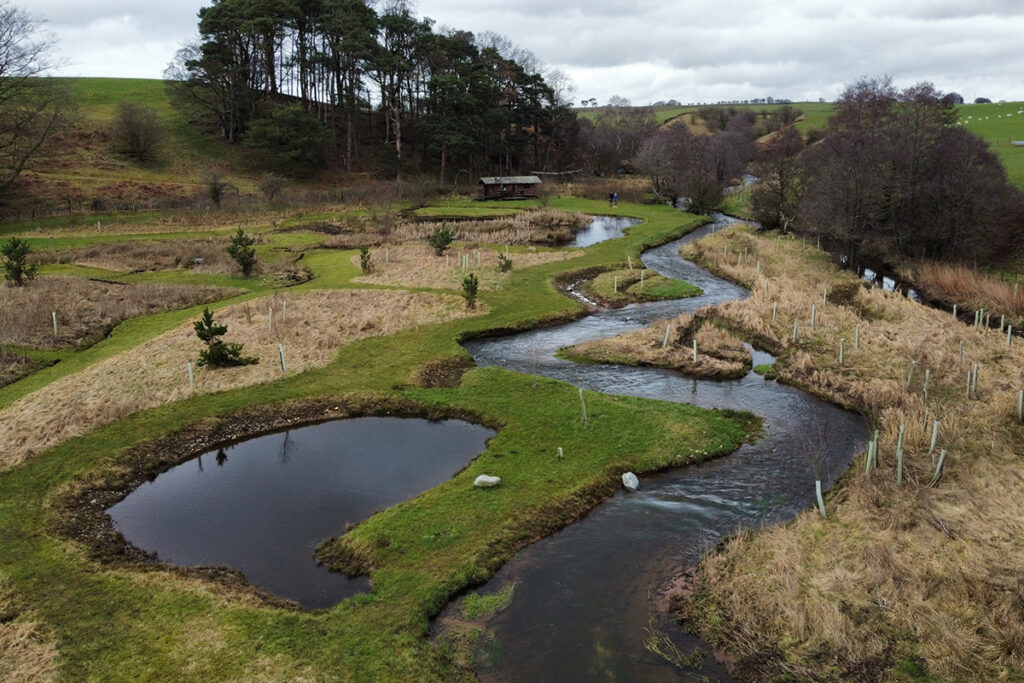Better Becks
Part of project: Natural flood management
This £328k natural flood management (NFM) and habitat improvement partnership project shows how working at a catchment scale to identify and install a wide variety of NFM features can help reduce flood risk for vulnerable communities, improve water quality, habitat connectivity and more over a wider area than a small, ad-hoc intervention could achieve.
Background
Helping to protect communities at risk of flooding has become a cornerstone of our conservation work in recent years. Our changing climate means that we need to find new ways to manage the flow of water from source to sea, especially during floods and drought.
It’s a carefully thought-out process involving research of the areas where interventions are required then working with the landowner to identify and agree the most appropriate measures and techniques from the natural flood management (NFM) toolbox that will work with nature to produce flood protection and create or enhance habitats.
We initially received support from the Environment Agency to carry out natural flood management work in the Cairn Beck catchment but wanted to extend this to other sub-catchments in the area to further reduce the risk of flooding to vulnerable communities.
As the lead partner of the Fellfoot Forward Landscape Partnership Scheme’s Better Becks project and thanks to additional support from Farming in Protected Landscapes with support from the North Pennines AONB Partnership and Slow the Flow from EA, we were able to extend this initial NFM delivery across new catchments in the Fellfoot area such as Glassonby, Gamblesby, Raven and Croglin.
From fencing to ‘re-wiggling’ rivers, between 2020 and 2022 we worked with 14 farms on a wide range of NFM interventions that have helped reduce downstream flood risk, improve water quality, sequester carbon and improve biodiversity.
In the Cairn Beck catchment, we have completed a 5km stretch of connected projects with a river restoration site at each end and hedges, riparian buffer strips, ponds and planting in the middle sections.
Here’s a flavour of some of the key projects completed:
Townfoot
A walkover in 2019 revealed a 230m stretch of highly straightened and canalised river between areas of naturally meandering sections of river with woodland cover and in-stream woody debris. Further research of OS maps and LiDAR data showed the old parish boundary as a curving / wiggly line – a good indication of where the river used to be.
This ambitious project aimed to restore the river to where it was pre-modification, creating numerous natural features – ponds, riffles and in-stream islands along the way. This re-wriggling added 165m to the length of the river! Natural rivers are dynamic, they don’t stay in one place, so a key feature of the design was to ensure that the river had space to move laterally over time.
The addition of fencing and a gate would mean that the field could still be used for light grazing and ERT volunteers planted trees that, as they grow, will help slow down surface water flow and intercept rainfall.
The river was reconnected with its floodplain, meaning that more water will be held here, for longer, during high rainfall instead of simply racing unchecked downstream towards vulnerable communities.
Funders: Farming in Protected Landscapes programme (with support from the North Pennines AONB Partnership), Environment Agency, ERT
Sumburgh
In the upper reaches of the Cairn Beck catchment, a highly straightened, incised ditch with little/no biodiversity present was perfect for the creation of a wetland.
We lowered the channel’s banks and created scrapes to allow it to reconnect with its floodplain and also infilled some of the channel to allow it to find its natural course and wet the floodplain.
Finally, in a new trial for ERT, we created two woody debris dams based on Beaver Dam Analogues (BDA’s) which have been used as a river restoration technique in America. These would allow water to seep through but also build up sediment behind them to raise the bed level and therefore encourage water out onto the floodplain. No fish are present in this section so fish movement is not a concern.
Funding: Defra/Environment Agency and North Pennines AONB/National Lottery Heritage Fund through the Fellfoot Forward LPS Better Becks project)
What’s next?
Whilst the Better Becks project has been completed, we will continue to work with the North Pennines AONB Partnership on NFM and environmental improvement projects as part of the Fellfoot Forward LPS. There are two funding pots still available to apply for:
- The Environment Grant through the Fellfoot Forward LPS is still available to apply for until 2024
- The Farming in Protected Landscapes (FiPL) funding is available for any farms within the North Pennines AONB area.
Please get in touch with us at [email protected] or contact North Pennines AONB Partnership if you have any projects you would like to discuss with us.












